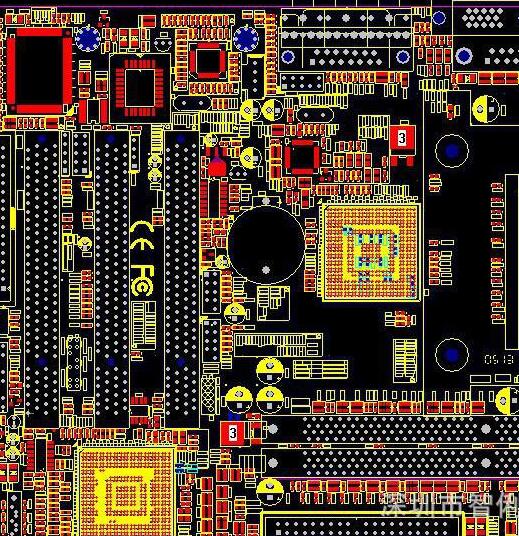Do you understand the classification of PCB board?
1. According to the rigidity and flexibility of the board, it is divided into two categories: rigid copper clad laminate and flexible copper clad laminate.
2. According to different reinforcement materials, it is divided into four categories: paper base, glass cloth base, composite base (CEM series, etc.) and special material base (ceramic, metal base, etc.).
(1) Paper substrate
Phenolic paper substrates (commonly known as, cardboard, rubber sheet, V0 board,flame retardant board, red letter copper clad laminate, 94V0, TV board, color TV board, etc., are the most widely used, and there are many famous brands, including Kingboard (KB character ), Changchun (L character), Doosan (DS character), Changxing (EC character), Hitachi (H character), etc.; insulating laminate material using phenolic resin as a binder and wood pulp fiber paper as a reinforcing material .Phenolic paper-based copper clad laminates can generally be punched. It has the advantages of low cost, low price and low relative density. The market competition is also quite fierce, and many domestic copper clad laminate manufacturers produce this type of board. But its work Lower temperature, humidity resistance and heat resistance are slightly lower than epoxy fiberglass cloth substrates. Paper substrates are mainly single-sided copper clad laminates, but in recent years, double-sided copper clad laminates for silver paste through holes have also appeared Products, international major manufacturers also produce double-sided copper clad laminates, such as Doosan (DS character). It has improved silver ion migration resistance compared to general phenolic paper-based copper clad laminates. The most commonly used product model for phenolic paper-based copper clad laminates is FR -1 (flame-retardant type) and XPC (non-flame-retardant type). Single-sided copper clad laminates can be easily judged from the color of the characters on the back of the plate. Generally, the red letter is FR-1 (flame retardant), and the blue letter is XPC (non-flame retardant). Flame retardant). This type of sheet is the cheapest compared to other types of sheet.

(2) Epoxy glass fiber cloth substrate
Epoxy fiberglass cloth substrate (commonly known as epoxy board, fiberglass board, fiberboard, FR4), epoxy fiberglass cloth substrate is a type of epoxy resin as the adhesive, and electronic grade glass fiber cloth as the reinforcing material Substrate. Its bonding sheet and inner core thin copper clad laminate are important substrates for making multilayer printed circuit boards. The operating temperature is high, and its performance is less affected by the environment. In terms of processing technology, it has great advantages over other resin glass fiber cloth substrates. This type of product is mainly used for double-sided PCBs, and is also about twice as expensive as phenolic paper substrates. The usual thickness is 1.5MM.
(3) Composite substrate (CEM)
Composite substrate (commonly known as powder board, etc., cem-1 board is also called 22F in some places in China) It mainly refers to CEM-1 and CEM-3 composite base copper clad laminate. Wood pulp fiber paper or cotton pulp fiber paper is used as the core reinforcement material, and glass fiber cloth is used as the surface reinforcement material. Both are impregnated with flame-retardant epoxy resin and made of copper clad laminate, called CEM-1. The glass fiber paper is used as the core reinforcement material, the glass fiber cloth is used as the surface reinforcement material, and the copper clad laminates are all impregnated with flame-retardant epoxy resin, called CEM-3. These two types of copper clad laminates are currently the most common composite base copper clad laminates. This type of sheet is cheaper than FR4 type sheet.
Flame retardant grade standard:
HB: UL94 and CSAC22.No0.17, the lowest flame retardant grade. It requires that the burning rate of samples with a thickness of 3 to 13 mm is less than 40 mm per minute, and for samples with a thickness of less than 3 mm, the burning rate is less than 70 mm per minute. Or go out before the 100mm mark.
V-1: After two 10-second burning tests on the sample, the flame goes out within 60 seconds. No burning objects should fall.
V-2: After two 10-second burning tests on the sample, the flame goes out within 60 seconds. There may be burning materials falling.
V-0: After two 10-second burning tests on the sample, the flame goes out within 30 seconds. No burning objects should fall.
1. The classification of PCB boards is already clear to everyone, so I won't say more;
2. The thickness of PCB board is classified according to national standards. There are mainly the following specifications:
0.5mm, 0.7mm, 0.8mm, 1.0mm, 1.2mm, 1.5mm, 1.6mm, 2.0mm, 2.4mm, 3.2mm, 6.4mm
1.6mm sheets are generally used for household appliances without special requirements;
3. The thickness of the copper foil on the PCB board is also divided according to national standards, mainly in the following specifications:
18um, 25um, 35um, 70um and 105um
The 35um copper foil thickness PCB is currently the mainstream of promotion, and household appliances generally choose the 35um copper foil thickness board. The metal purity required for copper foil is not less than 99.8%,
The thickness error is not more than ±5um, and the copper foil surface must not have scratches, sand holes and wrinkles. Thick copper clad laminates need to be considered for high current circuit boards, but household appliances can basically be ignored
this point.